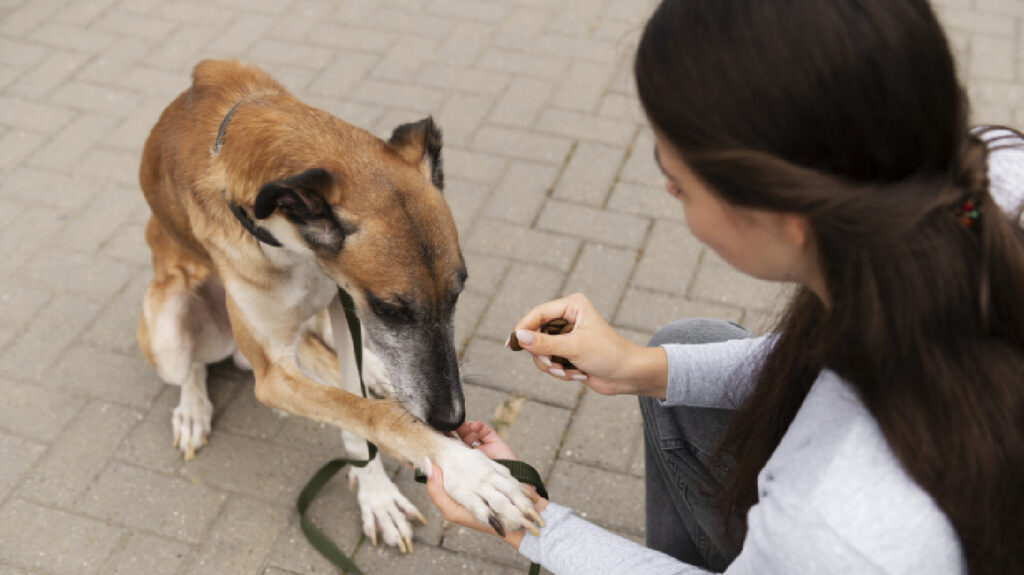
Mastering Basic Commands with Clicker Training: Sit, Stay, and More
In this comprehensive guide, we’ll delve into the world of clicker training for dogs and explore how it can be used to master basic commands such as sit, stay, come, and more. Clicker training is a positive and effective method that utilizes a small handheld device to mark desired behaviors, making it a popular choice for dog owners seeking to enhance their pet’s obedience and responsiveness.
If you’re curious about the ins and outs of clicker training and eager to learn how to teach your furry friend essential commands, then this article is your go-to resource.
We’ll cover the fundamentals of clicker training, the rationale behind its effectiveness, and provide practical tips for successfully mastering basic commands with this training approach. Whether you’re a novice or an experienced dog owner, this guide will equip you with valuable insights and techniques to help you and your dog achieve success in obedience training.
What is Clicker Training?
Clicker training is a positive reinforcement method used in dog training, aiming to modify behavior through precise communication and reinforcement.
It offers numerous benefits, such as fostering a strong bond between the trainer and the animal, enhancing learning and retention, and reducing stress for the animal. This method can be applied to various animals, including cats, horses, and exotic pets.
The core principle involves associating the sound of the clicker with a reward, such as treats or praise. Common clicker training tools include a clicker device, a target stick, and treats. Clear communication is essential in clicker training to ensure the animal understands the desired behavior and receives timely reinforcement.
How Does Clicker Training Work?
Clicker training works by associating the sound of a clicker with positive reinforcement, creating a clear signal to mark desired behaviors and facilitate the learning process for canines in a structured training program.
The principles of operant conditioning play a pivotal role in clicker training. By applying the concepts of positive reinforcement, the clicker becomes a powerful tool to reward and reinforce specific behaviors. This systematic approach encourages dogs to understand that certain actions result in favorable outcomes, promoting their willingness to engage and learn.
With consistent repetition and proper timing, clicker training establishes a strong foundation for desired behaviors and creates a harmonious bond between the trainer and the canine companion.
Why Use Clicker Training?
Clicker training is favored for its effectiveness in fostering obedience, modifying behavior, and refining training techniques, making it a valuable tool in canine training strategies.
This training method is particularly beneficial in addressing specific behavioral issues such as excessive barking, jumping, or aggression. By using positive reinforcement and precise timing, clicker training creates a clear line of communication between the trainer and the dog, which helps in achieving desired behaviors effectively.
To maximize its effectiveness, consistency is key. Consistently rewarding desired behaviors and ignoring undesired ones reinforces the learning process and encourages the dog to repeat the behaviors that are positively reinforced.
What are the Basic Commands in Clicker Training?
Clicker training encompasses a set of fundamental commands essential for dog obedience, including:
- sit
- stay
- come
- down
- leave it
- drop it
- heel
- wait
each forming the core of a comprehensive obedience training program.
These commands are vital in shaping desirable behavior and building a strong bond between dogs and their owners. For instance, the ‘sit’ command teaches dogs to be calm and patient, ‘stay’ ensures they remain in place even when distracted, ‘come’ establishes reliable recall, while ‘down’ encourages relaxation. Additionally, ‘leave it’ and ‘drop it’ prevent them from grabbing unwanted items, ‘heel’ establishes walking etiquette, and ‘wait’ instills impulse control. By mastering these commands, dogs become well-behaved and responsive to their owners’ directives.”
How to Teach Your Dog the Basic Commands?
Teaching your dog the basic commands involves utilizing the clicker during training sessions, implementing effective training methods, and adopting a positive and consistent training approach, with the dog handler playing a crucial role in guiding behavioral training.
When introducing a new command, start by capturing the behavior you desire and clicks at the exact moment your dog performs it. Follow this with a treat to reinforce the association between the click and reward. Gradually, label the behavior with a verbal cue as your dog begins to understand, then fade out the clicker as the behavior becomes consistent.
Remember to keep training sessions short and positive, setting your dog up for success. Consistency and patience are key in effectively teaching your dog the basic commands through clicker training.
What are Some Tips for Mastering Basic Commands with Clicker Training?
Mastering basic commands through clicker training requires regular practice in different environments, short yet focused training sessions, and the application of positive reinforcement techniques to refine training skills and enhance the overall training experience.
Consistency in training sessions is key to reinforcing the learned commands effectively. It’s essential to create a structured training routine that includes a variety of environments, such as indoors and outdoors, to help the dog generalize the commands.
Using a clicker helps to mark the desired behavior precisely, making it clear to the dog what action is being rewarded. The incorporation of positive reinforcement, such as treats, praise, or toys, creates a positive association with obeying commands and motivates the dog to engage in the training process enthusiastically.
What are the Basic Commands in Clicker Training?
The basic commands in clicker training include sit, stay, come, down, leave it, drop it, heel, and wait, forming the foundation of positive reinforcement and effective communication in dog training.
Sit
Teaching a dog to sit through clicker training involves using positive reinforcement techniques, clear communication, and consistent training tips to ensure obedience and behavioral modification.
This process begins by introducing the clicker as a signal for desired behavior, such as sitting. When the dog sits, immediately click the device and follow it with a small treat to reinforce the action. Consistency is key; practice the sit command in various environments to generalize the behavior. Gradually, phase out the clicker, relying solely on verbal cues and occasional rewards. Remember to be patient and offer praise each time the dog successfully sits, encouraging a positive association with the command.
Stay
The ‘stay’ command in clicker training focuses on teaching a dog to remain in place, using positive reinforcement, effective training strategies, and valuable tips to ensure consistent obedience and behavioral compliance.
This type of training involves teaching the dog to hold a specific position until released, which is an essential skill for any well-behaved canine companion. To achieve success, trainers can start with short durations and gradually increase the time, always rewarding the dog for compliance. It’s important to maintain consistent expectations and clear communication to avoid confusion. Creating a calm and distraction-free environment during training sessions can greatly assist in achieving positive outcomes with the ‘stay’ command.
Come
Teaching a dog the ‘come’ command through clicker training involves utilizing positive reinforcement, effective training techniques, and valuable tips to ensure reliable recall and obedience.
This training process starts by associating the sound of the clicker with a reward, usually a high-value treat. When the dog comes to you upon hearing the command ‘come’, use the clicker and reward the behavior immediately.
Consistency is crucial; ensure that every successful response to the command is met with praise and treats. Gradually increase the distance and distractions while practicing the ‘come’ command to solidify the behavior in various situations. Remember, patience and consistency are key when teaching this essential obedience behavior.
Down
The ‘down’ command in clicker training focuses on teaching a dog to lie down, utilizing positive reinforcement, effective training strategies, and valuable tips to encourage consistent obedience and behavioral modification.
This obedience behavior is often used in various scenarios, including calming an excited dog, preventing jumping up on people, and initiating more advanced training exercises. To train the ‘down’ command, start by capturing the behavior – click and treat whenever the dog naturally lies down. Gradually introduce the verbal cue ‘down’ and use the clicker and treats to reinforce the action. Consistency, patience, and praise are essential in ensuring that the dog understands and performs the ‘down’ command reliably in different environments and situations.
Leave It
The ‘leave it’ command in clicker training focuses on teaching a dog to ignore certain stimuli, utilizing positive reinforcement, effective training techniques, and valuable tips to encourage consistent obedience and behavioral compliance.
This crucial command can be established through systematic desensitization, where the dog is gradually exposed to the trigger and then rewarded for redirecting attention. A key tip is to start with less tempting items and progressively increase the level of difficulty. Incorporating a clear cue and consistently rewarding the desired response is essential.
It’s important to build trust and create a positive association with the ‘leave it’ command, as this will lead to reliable and prompt obedience in real-life scenarios.
Drop It
The ‘drop it’ command in clicker training focuses on teaching a dog to release items on cue, utilizing positive reinforcement, effective training strategies, and valuable tips to ensure consistent obedience and behavioral modification.
This training typically begins by teaching the dog to hold an item in its mouth and then, using the clicker, prompt the ‘drop it’ command followed by a reward. Consistency and patience are key in reinforcing this behavior, gradually increasing the difficulty by introducing different objects.
For instance, practicing with toys, then moving onto items of varying textures. It’s essential to praise and reward the dog every time it successfully executes the ‘drop it’ command, helping to instill this crucial behavior.”
Heel
The ‘heel’ command in clicker training focuses on teaching a dog to walk closely beside the handler, utilizing positive reinforcement, effective training techniques, and valuable tips to ensure consistent obedience and behavioral compliance.
This fundamental obedience behavior is crucial for maintaining control and ensuring safety during walks. To train the ‘heel’ command, start by rewarding your dog for staying by your side and walking without pulling. Use the clicker to mark the desired behavior and follow it with a high-value treat.
Consistency is key, so practice in low-distraction environments before gradually increasing the level of difficulty. Utilizing a consistent cue and reinforcing the behavior with rewards will help establish a reliable ‘heel’ command.”
Wait
The ‘wait’ command in clicker training focuses on teaching a dog to pause and exercise self-control, utilizing positive reinforcement, effective training strategies, and valuable tips to ensure consistent obedience and behavioral modification.
This obedience behavior is essential for managing impulse control and preventing impulsive actions, such as rushing out of doors or diving into food bowls. To train the ‘wait’ command, begin in a quiet space with minimal distractions. Use the clicker to mark the moment your dog stops, then immediately reward with a treat. Gradually increase the time between the ‘wait’ command and the click, reinforcing the pause. Implementing this training with patience and consistency will develop a reliable ‘wait’ command, ensuring your dog’s obedience in various settings.
How to Teach Your Dog the Basic Commands?
Teaching your dog the basic commands through clicker training involves incorporating the clicker during training sessions, utilizing positive reinforcement, and applying effective training tools to ensure successful acquisition and retention of the desired behaviors.
Start with the Clicker
The initial step in teaching basic commands through clicker training involves introducing the clicker as a consistent and precise marker for desired behaviors, emphasizing positive reinforcement and effective training techniques to lay a strong foundation for subsequent training.
This tool plays a crucial role in establishing clear communication between the trainer and the pet, as it provides instant feedback to the animal, signaling the exact moment the desired behavior occurs. By using the clicker to pinpoint and reinforce positive actions, the pet quickly learns to associate the sound with a reward, making the training process more effective and enjoyable.
When introducing the clicker, it’s essential to pair the click with a treat or a positive reinforcement to create a strong association. Starting with simple commands like ‘sit’ or ‘come’ and timing the click precisely to coincide with the desired action helps solidify the behavior and build a strong foundation for future training.
Reward with Treats
Rewarding the dog with treats forms an integral part of clicker training, using positive reinforcement to encourage and solidify the acquisition of basic commands, fostering obedience and enthusiastic participation in the training process.
It’s crucial to select high-value treats that appeal to your dog’s preferences, such as small pieces of cooked chicken or freeze-dried liver, to ensure maximum motivation. When using treats, it’s important to deliver them promptly after the desired behavior, linking the reward to the action. Gradually, as your dog becomes more proficient, you can reduce the frequency of treat use and transition to intermittent reinforcement, maintaining their motivation.
Varying the types of treats and occasionally incorporating verbal praise can help keep the rewards novel and engaging.
Use a Clear Cue
Employing a clear and consistent cue alongside the clicker aids in creating a strong association between the command, the desired behavior, and the positive reinforcement, facilitating effective communication and enhancing the learning process for the dog.
This can be achieved by carefully selecting cues that are distinct and easily recognizable, such as unique verbal commands or specific hand signals. When introducing a new cue, it’s essential to pair it consistently with the desired behavior and reinforce it with the clicker and a reward.
Consistent repetition and reinforcement of the cue will help the dog quickly associate it with the intended action, leading to more precise and reliable responses during training sessions.
Be Consistent and Patient
Consistency and patience are essential attributes in clicker training, fostering an environment of predictability and encouragement for the dog, ensuring successful learning, and the acquisition of basic commands through positive reinforcement techniques.
Maintaining consistency involves following a regular training schedule and using the same commands and hand signals. It’s also important to offer rewards consistently when the dog exhibits the desired behavior. Patience is key as dogs may vary in their learning pace, requiring understanding and encouragement. Remaining calm and positive during training sessions is crucial to create a supportive learning environment.
When these principles are consistently applied, the dog will gradually grasp and master the basic commands, paving the way for more advanced training.
What are Some Tips for Mastering Basic Commands with Clicker Training?
Mastering basic commands through clicker training requires regular practice in different environments, short yet focused training sessions, and the application of positive reinforcement techniques to refine training skills and enhance the overall training experience.




No Comments